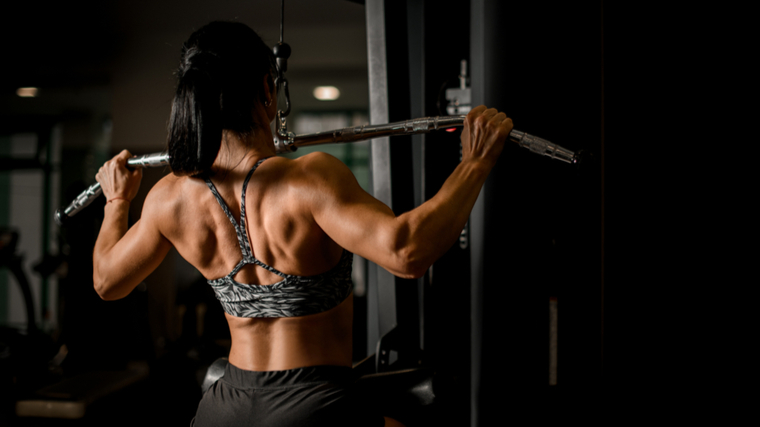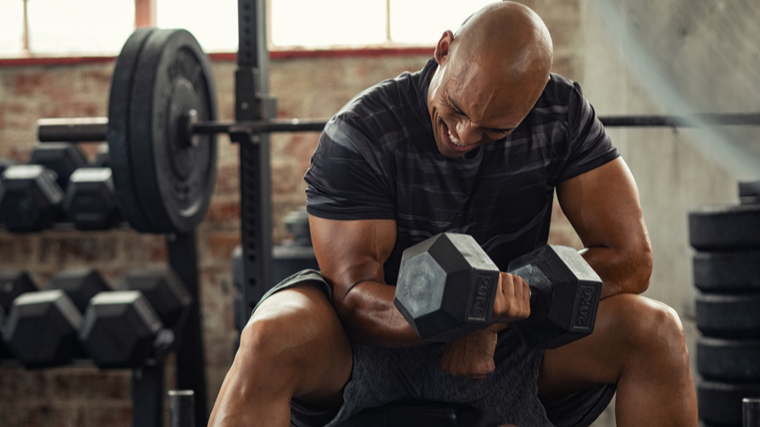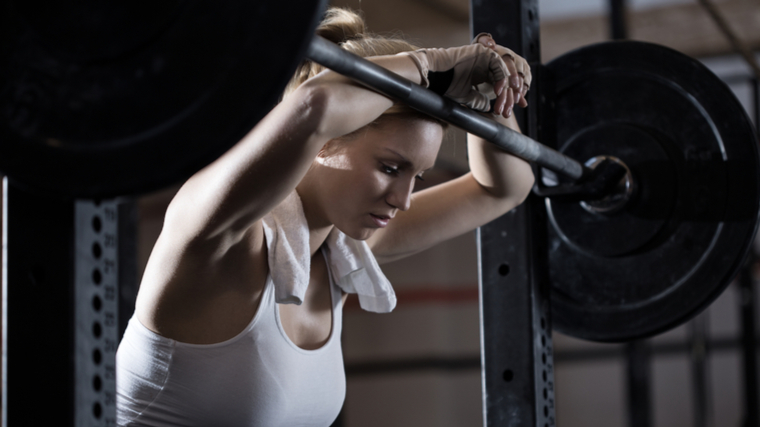The form police are a diligent bunch. From the deepest reaches of social media comment sections to unwelcome solicitations in the weight room, you can always find someone willing to “help” you with your lifting technique, whether you like it or not.
While interrupting someone mid-set to advise them on their squats may run afoul of gym etiquette, good lifting form is as important to the starry-eyed, first-day-with-a-dumbbell gymgoer as it is to the ten-year veteran pursuing another win in the IFBB Pro League. Or is it?

Resistance training should be safe, healthy, and effective. But some surgical deviations from “textbook” technique on specific exercises might help you squeeze out more gains from every rep you perform. These are some of the best exercises to let loose on in the gym.
- What is Exercise Cheating?
- Best Bodybuilding Exercises to Cheat On
- Worst Bodybuilding Exercises to Cheat On
- Benefits of Cheating Your Form
Editor’s Note: The content on BarBend is meant to be informative in nature, but it should not be taken as medical advice. When starting a new training regimen and/or diet, it is always a good idea to consult with a trusted medical professional. We are not a medical resource. The opinions and articles on this site are not intended for use as diagnosis, prevention, and/or treatment of health problems. They are not substitutes for consulting a qualified medical professional.
What is Exercise Cheating?
Simply put, “cheating” in the context of lifting weights refers to any physical adjustment you make to your standard technique that helps you lift heavier or for a longer duration. Cheating your lifts isn’t necessarily the same as making a movement compensation.
If you have low ankle mobility, you might struggle to squat as deep as someone who doesn’t have that kind of restriction. However, that doesn’t mean you’re “cheating” during your squats. A reduced range of motion would make it easier for you to lift more weight — other factors aside — but poor dorsiflexion isn’t a decision you make on purpose.
Conversely, most lifters would consider it cheating to incorporate momentum into an exercise like the barbell row. If you start swaying your torso on each rep in order to more easily lift the bar, you’re “cheating,” since the default technique for most rows mandates a static trunk.
Best Bodybuilding Exercises to Cheat On
Don’t get it twisted — your form matters in the gym. Good technique helps you target the right muscles and, for the most part, stave off potential injuries or accidents. Textbook movement may not be the best course of action in all cases, though. Some exercises may work even better without.
Dumbbell Row
The dumbbell row is a phenomenal all-around back-builder. It does, however, suffer from an inconsistent resistance curve. You’ll generally find the dumbbell row to be easy at the bottom and very, very hard at the top, as your arm tucks up against your torso.
However, the second half of the movement is where your lats are the most engaged from a mechanical perspective. If you find you can’t quite eke out the back half of your rows with good form, you might be leaving gains on the table. A bit of light swinging to get your rows started will ensure that you’re getting as much value as you can from every rep.
Shrug
There aren’t many bodybuilding exercises that are conducive to ballistic movement. Shrugs stand out in this regard due to their small range of motion coupled with a very high loading potential.
A short range of motion technically means a limited time under tension, unless you’re willing to incorporate a high rep count. Your traps are well-suited to performing explosive contractions, so you might discover that “power shrugs” with some rhythmic bouncing absolutely annihilate your traps.
You’ll probably find it difficult to keep a tight grip on the barbell or dumbbells you’re using, so have a good pair of straps handy.
Biceps Curl
It may come as a mild surprise given the small size of the muscle that the biceps are made up of mostly Type II, fast-twitch muscle fibers. (3) As such, you can actually make respectable arm gains by reducing your reps and cranking up the weight.
This, coupled with the physiological benefits of eccentric loading, actually make the cheat curl a viable way to build your guns. As long as you keep strict control over the lowering portion, you can lightly swing your hips to initiate some ultra-heavy curls.
Chest Press
Cheating isn’t all about using momentum. If you care about building your pecs, you can tactfully omit some of the range of motion on your presses in a way that benefits you.
Your pec muscles are almost entirely responsible for lifting a barbell or pair of dumbbells off your chest, but their involvement tapers off dramatically as your arms extend above you.
If you want to prioritize chest growth above all else, you can cut out the top third of your range of motion on most presses. This will, however, reduce the stimulation your triceps receive.
Split Squat
Single-leg exercises like the Bulgarian split squat are second-to-none for targeted stimulation and correcting muscular imbalances. They’re also great for improving your balance and coordination — qualities that are of limited relevance to a physique purist.
You can hold onto a fixed structure like a bench, pole, or machine to stabilize your body while you perform a single-legged squat. This will remove the stability requirement of the exercise almost entirely, allowing you to focus on contracting your quads and glutes for better growth.
Lateral Raise
Lateral raises with dumbbells are easy to start but difficult to finish. They also place more tension on your deltoid the higher you lift your arm. With these two factors in mind, some light momentum can really ante up the efficacy of the exercise.
As long as you’re diligent and deliberately slow down your eccentric, you’ll notice that laterals tear your delts to shreds if you can raise your arm all the way up every time.
Worst Bodybuilding Exercises to Cheat On
No exercise is inherently injurious. Anyone who says otherwise has a myopic view of human movement or is trying to sell you something. That said, some lifts do place your joints and tissues under greater strain than others.
From the perspective of physique development, certain movements also have very strict form requirements in order to be effective. You not only need to know which exercises have wiggle room, but which ones don’t.
Lateral Raise
There’s a case to be made for lateral raises as one of the best — and worst — exercises you can cheat on. Some mild swinging may help with deltoid engagement, but you can just as easily turn the lateral raise into an upper back movement instead.
Your trapezius muscles assist in abducting your arm the same way your side delts do. Sloppy technique can therefore take tension off the target muscle and turn your lateral raises into a trap exercise if you’re not careful.
Good Morning
The good morning allows you to do a lot with a little. Hinging at the hip with the barbell on your upper back creates a significant moment arm, which makes even a very light weight feel quite challenging to your posterior chain.
This is also the exact reason that you should be very, very diligent about your form. To properly execute a good morning, you must maintain perfect spinal rigidity from your sacrum to your skull. Steer clear of heavy weights and make sure you sit into your hinge slowly.
Lat Pulldown
The lat pulldown is one of the best cable exercises you can do. It mimics the motor pattern of a pull-up without requiring you to lift your own body weight or maintain external stability.
However, most pulldown stations have pads for you to brace your legs against, and it’s all too common for lifters to use them to yank on the cable attachment and bastardize the movement. If you yank on the cable and lean back during your reps, you’re compromising the exercise in more than one way.
Not only will this usually reduce your mind-muscle connection, but leaning back excessively puts the line of pull at odds with the orientation of your lats. If you do pulldowns with a wider grip, this might take your lats out of the movement significantly.
Face Pull
Your upper back is comprised of a series of small muscles with specialized functions, and the face pull is a great way to train them. That said, you have to be extremely precise about your movement when training smaller muscles with specific actions.
The face pull helps train scapular retraction and external rotation. The latter movement is controlled by your rear delts, infraspinatus, and other tiny muscles that attach to your shoulder blade.
When you hit up a set of face pulls, make sure you’re going slow and actively rotating your shoulder — think about performing a double biceps flex, or “opening up” the inside of your arm so it faces forward.
Benefits of Cheating Your Form
It may seem obvious, but for a bodybuilder, picture-perfect technique in the gym isn’t the endgame — growing muscle is. Tight form during your workouts is respectable, but shouldn’t necessarily be a goal unto itself.
Your technique is meant to be both safe and effective, and is more of a balancing act than a box to check.
Heavier Weights
Since most styles of cheating involve improving your leverages rather than compromising them, you should be able to work with heavier loads overall if you’re willing to relax your technical standards a bit.
Heavier weights not only drive greater gains in strength over time, but place more mechanical tension on your muscle fibers as well. Higher levels of mechanical tension is one of the best ways to induce hypertrophy.
Force Development
Adding some physical slang to your lifting can also make you a more kinetic athlete overall. Even if you only care about bulking up and not how fast you can run, lift, or throw, you shouldn’t neglect power training entirely as a bodybuilder.
Some literature suggests that lifting light weights quickly and with a high degree of force produces a similar hypertrophic response to working with heavier loads and moving more slowly — as long as you equate your total time under tension. (1)

Rate of force development is an extremely valuable skill to have, whether you’re training for the weightlifting platform or the bodybuilding stage.
Better Load Profiling
An exercise’s load profile refers to how the resistance you’re working with is distributed throughout the range of motion. Some exercises, like the lateral raise, are very easy when your arm is at your side and get exponentially harder as you raise your arm.
When you’re trying to fully fatigue your deltoids for growth, you don’t want physics to get in the way of gains. A bit of body English to kickstart the final few reps of your set can ensure that you’re actually working your muscles in their most vulnerable positions.
More Movement Longevity
If you enjoy a certain exercise but find it difficult to progress it through traditional means, some intentional cheating can serve as a way to keep that movement in your program a bit longer.
Even a minor adjustment to your form may constitute a significant difference in how the exercise feels on your body, which helps keep your training fresh and fun.
Higher Eccentric Tension
In order to achieve optimal muscle growth, you need to perform both concentric and eccentric action, meaning you must both lift a weight against gravity and resist gravity in kind. However, some research has postulated that eccentric loading can be particularly effective for driving muscle growth as well as strength adaptations. (2)

You’ll find that you have an easier time resisting a weight than lifting it. As such, a bit of cheating on the concentric portion of an exercise may allow you to work with heavier weights and lower them under control. This may produce better gains as part of a balanced training plan long-term.
Lift Above the Law
If you’ve been in the bodybuilding game awhile, you’ve probably thought back to your first days and flinched at how you worked with the weights. On the other hand, that might be where you’re at right now.
Your first steps in any endeavor are always clumsy. Exercise form provides a much-needed structure that balances safety and efficacy. But after you’ve learned the ropes and want to push your limits, technique begins to look like more of a guideline than a hard rule.
Once you’ve learned the rules of the weight room, break them — but do so intelligently. Some swinging here or shortened range of motion there can help you intensify your workouts and, as a reward for your lawlessness, help bring you heaps of new muscle to play with.
References
- Mohamad, N. I., Cronin, J. B., & Nosaka, K. K. (2012). Difference in kinematics and kinetics between high- and low-velocity resistance loading equated by volume: implications for hypertrophy training. Journal of strength and conditioning research, 26(1), 269–275.
- Franchi, M. V., Reeves, N. D., & Narici, M. V. (2017). Skeletal Muscle Remodeling in Response to Eccentric vs. Concentric Loading: Morphological, Molecular, and Metabolic Adaptations. Frontiers in physiology, 8, 447.
- Klein, C. S., Marsh, G. D., Petrella, R. J., & Rice, C. L. (2003). Muscle fiber number in the biceps brachii muscle of young and old men. Muscle & nerve, 28(1), 62–68.
Featured Image: Maksym Fesenko / Shutterstock